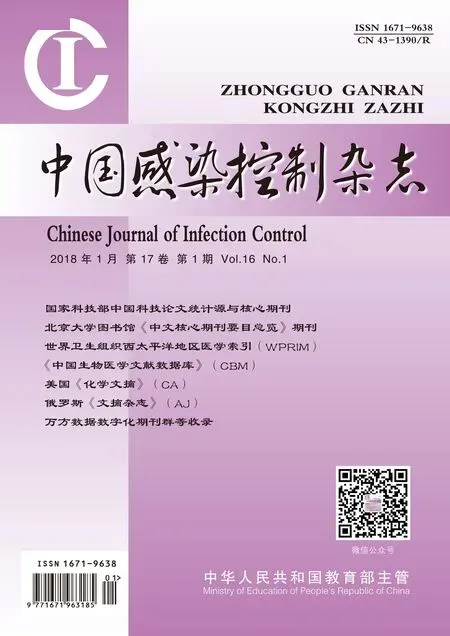高毒力肺炎克雷伯菌血流感染的临床特点
马荣, 王晓丹, 聂大平
(大连医科大学第二临床学院,辽宁 大连 116027)
·论著·
高毒力肺炎克雷伯菌血流感染的临床特点
马荣, 王晓丹, 聂大平
(大连医科大学第二临床学院,辽宁 大连 116027)

高毒力肺炎克雷伯菌; 经典型肺炎克雷伯菌; 肺炎克雷伯菌; 血流感染; 社区感染; 医院感染
二十世纪八十年代中期,肺炎克雷伯菌所致的肝脓肿首先在台湾受到关注,因为这种肺炎克雷伯菌可感染无基础疾病的健康人,有远距离转移感染的能力,即肝脓肿可转移到脑、肺和眼形成脑脓肿、肺脓肿和眼内炎[1]。该菌株有特殊表型,即在血平板上形成高黏菌落,拉丝试验的长度>5 mm等特点,这些特点形成的基础是丰富的荚膜多糖。荚膜多糖的合成与细菌中胞外多糖合成调节因子rmpA基因密切相关。这种高黏性能可抵御中性粒细胞吞噬,故将高黏表型肺炎克雷伯菌命名为高毒力肺炎克雷伯菌(hypervirulentKlebsiellapneumoniae, hvKP),高黏菌落和rmpA基因是其标志[1-3]。此外,它们有特定的荚膜多糖血清型(K1、K2、K5、K20、K54和K57),临床最常见和毒力最强的菌株是K1和K2型肺炎克雷伯菌,因为它们较其他血清型有更强的抗吞噬能力和对血清的抵抗性[4]。hvKP可作为正常菌群定植于人体上呼吸道和肠道[5-6],主要引起社区获得性感染,如肝脓肿、社区获得性肺炎(community-associated pneumonia, CAP)、泌尿系统感染、坏死性筋膜炎等[1-7]。这些感染原来主要见于亚洲地区,近年来已蔓延到全球。引起的血流感染(bloodstream infection, BSI)也日益增多,对其感染来源和临床特点的报道不多,故本研究将某医院2013年4月—2016年3月hvKP BSI与经典型肺炎克雷伯菌(classicKlebsiellapneumoniae, cKP)BSI进行比较,现报告如下。
1 对象与方法
1.1 研究对象 收集2013年4月—2016年3月大连医科大学第二临床学院159例肺炎克雷伯菌BSI患者的菌株和临床资料。社区感染和医院感染按照国家卫生部2001年发布的《医院感染诊断标准(试行)》判定。
1.2 方法
1.2.1 仪器和试剂 VITEK 2 Compact全自动微生物鉴定仪,PCR扩增仪(Light Cycler 480),紫外分析仪电泳仪。试剂:PCR反应液,DNA产物纯化试剂盒(天根生化科技有限公司),PCR引物,DNAMaker DL2000(大连宝生物工程有限公司)。
1.2.2 药敏和产ESBLs株鉴定 159株细菌由VITEK 2 Compact全自动微生物鉴定仪鉴定为肺炎克雷伯菌,产ESBLs菌株也由该仪器判定。药敏判断标准参考美国临床实验室标准化协会(CLSI)2013年标准。
1.2.3 肺炎克雷伯菌高黏表型、K1、K2和rmpA基因检测和高毒力菌判定 (1)拉丝试验:使用接种环挑取血平板上生长菌落,其黏液丝长度≥5 mm为阳性,<5 mm为阴性。(2)多重PCR扩增K1、K2和rmpA基因:煮沸法提取细菌DNA,K1、K2和rmpA基因的引物和产物大小见表1,反应条件参考文献[8]; PCR反应体系25 μL,三对引物正反引物各1 μL,模板4 μL,反应液12.5 μL,蒸馏水补足至25 μL。(3)反应条件:预变性95℃ 5 min;95℃ 45 s,58℃ 90 s,72℃ 90 s,35个循环;延伸72℃ 10 min。(4)PCR产物确定:取PCR产物10 μL进行2%琼脂糖凝胶电泳,紫外成像仪观察,纯化PCR产物,大连市宝生物工程有限公司测序,在BLAST、GenBank上检索比对。拉丝试验和rmpA基因同时阳性判为hvKP[9]。

表1 K1、K2 荚膜型及rmpA基因PCR扩增引物、产物大小
1.3 统计分析 应用SPSS 19.0软件进行数据分析。计数资料采用χ2检验,P≤0.05为差异具有统计学意义。
2 结果
2.1 hvKP和荚膜多糖血清型检出率 PCR扩增血清型K1、K2和rmpA基因扩增出条带分别为1 283、641和516 bp,与预测值相符。见图1。测序结果K1、K2、rmpA分别为AB 355924.1、AB 362363.1和AB 289642.1,符合率为99.9%。159例肺炎克雷伯菌BSI分离株中,拉丝试验阳性菌株为56株,rmpA基因阳性株59株,二者共同阳性56株,即 35.22%(56/159)为hvKP。K1型为51.79%(29/56),K2型为26.79%(15/56)。
2.2 hvKP和cKP BSI患者感染来源 hvKP BSI感染来源主要为肝脓肿(26株,46.43%)和CAP(13株,23.21%);cKP BSI主要是原发性菌血症(41株,39.81%)和胆道感染(28株,27.18%)。hvKP和cKP BSI患者的不同感染来源构成比较,差异有统计学意义(χ2=77.639,P<0.001)。见表2。

图1 hvKP K1、K2和rmpA基因PCR扩增产物电泳图
Figure1Electrophoresis map of polymerase chain reaction amplification products of K1, K2 andrmpA gene of hvKP

表2 cKP及不同血清型hvKP BSI感染来源分布
2.3 hvKP和cKP BSI患者临床特点 hvKP和cKP BSI患者在年龄、性别、30 d内死亡情况比较,差异均无统计学意义(均P>0.05)。两组患者不同感染类型比较,差异有统计学意义(χ2=57.782,P<0.001),hvKP BSI患者以社区获得性为主(89.29%),cKP BSI患者以医院获得性为主(73.79%)。两组患者不同基础疾病构成比较,差异有统计学意义(χ2=36.532,P<0.001),hvKP BSI患者主要为糖尿病(50.00%),cKP BSI患者主要为恶性肿瘤(45.63%)。hvKP BSI患者感染性休克发生率高于cKP BSI患者(32.14% vs 8.74%),差异有统计学意义(χ2=14.096,P<0.001)。见表3。
表3hvKP和cKP BSI患者的临床特点[例(%)]
Table3Clinical features of patients with hvKP BSI and cKP BSI(No. of cases[%])

基本信息hvKP(n=56)cKP(n=103)χ2P年龄(岁)0.8790.348 ≥6025(44.64)54(52.43) <6031(55.36)49(47.57)性别0.0180.892 男32(57.14)60(58.25) 女24(42.86)43(41.75)感染类型57.782<0.001 社区获得性50(89.29)27(26.21) 医院获得性6(10.71)76(73.79)基础疾病36.532<0.001 糖尿病28(50.00)32(31.07) 胆道疾病2(3.57)4(3.88) 肝硬化5(8.93)13(12.62) 脑血管疾病2(3.57)14(13.59) 慢性肾病2(3.57)8(7.77) 恶性肿瘤7(12.50)47(45.63) 肺部疾病1(1.79)3(2.91) 心脏病1(1.79)1(0.97) 自身免疫性疾病2(3.57)0(0.00) 无基础疾病8(14.29)1(0.97)感染性休克14.096<0.001 是18(32.14)9(8.74) 否38(67.86)94(91.26)30d内死亡2.3230.127 是4(7.14)16(15.53) 否52(92.86)87(84.47)

3 讨论
本研究显示159例肺炎克雷伯菌BSI患者中56例为hvKP BSI,占35.22%, 其中,K1和K2型占78.57%(44/56),且K1型肺炎克雷伯菌远多于K2型。 56例hvKP BSI中社区获得性感染50例,占89.29%,感染来源主要是肝脓肿和CAP,与文献[10-11]报道一致。hvKP易感染糖尿病患者,与高糖环境损害机体免疫系统,进而增强hvKP合成荚膜多糖能力、提高细菌侵袭力和抵抗中性粒细胞吞噬的能力有关[12];而且它们也能感染无基础疾病的健康人。本研究中hvKP BSI中糖尿病患者为50.00%,无基础疾病感染者为14.29%,高于cKP BSI的31.07%和0.97%。cKP BSI感染来源主要是原发性菌血症、胆道感染和HAP,基础疾病主要是恶性肿瘤。两种肺炎克雷伯菌BSI患者的年龄与性别差异无统计学意义。

表4 hvKP与cKP对常见抗菌药物耐药情况
*:Fisher确切概率法
hvKP BSI特点是病情重、进展快、发生脓毒性休克风险高。有研究[13]表明在肺炎克雷伯菌BSI中,hvKP与脓毒性休克的发生相关。上海报道了3例由K2型肺炎克雷伯菌所致的肺炎,患者在24 h内死亡[14]。本研究hvKP BSI感染性休克发生率高于cKP BSI。但30 d内病死率与cKP BSI没有差异。hvKP BSI感染性休克主要集中在肝脓肿和CAP,发生感染性休克者77.78%的患有糖尿病。研究[15]表明糖尿病血糖控制不佳的患者在感染肺炎克雷伯菌时,感染性休克出现的概率增加,因此,对hvKP BSI的糖尿病患者,一定要关注血糖的控制。
hvKP除对氨苄西林天然耐药外,通常对临床常用抗菌药物敏感,随着耐药质粒在医院内传播,国内已出现产ESBLs和KPC hvKP[16-17],本研究中hvKP BSI产ESBLs比率为5.36%,尚未发现产KPC的hvKP,3株产酶菌均来自医院获得性感染。来源可能是定植于机体呼吸道和肠道的hvKP在抗菌药物使用过程中筛选出耐药质粒或从其他产ESBLs肠杆菌中获得耐药质粒。感染这种高侵袭力加耐药基因的菌株会增加治疗的难度和费用,故应合理使用抗菌药物,加强监测,做好隔离,减少医院内流行。
总之hvKP BSI多为社区获得性感染,患者多有糖尿病,容易发生感染性休克。实验室和临床医生都应重视hvKP感染并密切关注其耐药趋势的演变。
[1] Shon AS, Bajwa RP, Russo TA. Hypervirulent (hypermucoviscous)Klebsiellapneumoniae: A new and dangerous breed[J]. Virulence, 2013, 4(2): 107-118.
[2] Guo S, Xu J ,Wei Y, et al. Clincal and molecular characteristics ofKlebsiellapneumoniaeventilator-associated pneumonia in mainland China[J]. BMC Infect Dis, 2016, 16(1): 608-613.
[3] Hsu CR, Lin TL, Chen HC, et al. The role ofKlebsiellapneumoniaermpA in capsular polysaccharide synthesis and virulence revisited[J]. Microbiology, 2011, 157(Pt 12): 3446-3457.
[4] Lee HC, Chuang YC, Yu WL, et al. Clinical implications of hypermucoviscosity phenotype inKlebsiellapneumoniaeisolates: association with invasive syndrome in patients with community-acquired bacteraemia[J]. J Intern Med, 2006, 259(6): 606-614.
[5] Lin YT, Wang YP, Wang FD, et al. Community-onsetKlebsiellapneumoniaein Taiwan: clinical features of the disease and associated microbiological characteristics of isolates from pneumonia and nasopharynx[J]. Front Microbiol, 2015, 9: 122.
[6] Chung DR, Lee H, Park MH, et al. Fecal carriage of serotype K1KlebsiellapneumoniaeST23 strains closely related to liver abscess isolates in Koreans living in Korea[J]. Eur J Clin Microbiol Infect Dis, 2012, 31(4): 481-486.
[7] Cheng NC, Yu YC, Tai HC, et al. Recent trend of necrotizing fasciitis in Taiwan: focus on monomicrobialKlebsiellapneumoniaenecrotizing fasciitis[J]. Clin Infect Dis, 2012, 55(7): 930-939.
[8] Turton JF, Perry C, Elgohari S, et al. PCR characterization and typing ofKlebsiellapneumoniaeusing capsular type-specific, variable number tandem repeat and virulence gene targets[J]. J Med Microbiol, 2010, 59(pt5): 541-547.
[9] Yu WL, Lee MF, Chen CC, et al. Impacts of hypervirulence determinants on clinical features and outcomes of bacteremia caused by extended-spectrum β-lactamase-producingKlebsiellapneumoniae[J]. Microb Drug Resist, 2017, 23(3): 376-383.
[10] Cubero M, Grau I, Tubau F, et al. HypervirulentKlebsiellapneumoniaeclones causing bacteraemia in adults in a teaching hospital in Barcelona, Spain (2007-2013) [J]. Clin Microbiol Infect, 2016, 22(2): 154-160.
[11] Liu YM, Li BB, Zhang YY, et al. Clinical and molecular characteristics of emerging hypervirulentKlebsiellapneumoniaebloodstream infections in mainland China[J]. Antimicrob Agents Chemother, 2014, 58(9): 5379-5385.
[12] Lee CH, Chen IL, Chuah SK, et al. Impact of glycemic control on capsular polysaccharide biosynthesis and opsonophagocytosis ofKlebsiellapneumoniae: Implications for invasive syndrome in patients with diabetes mellitus[J]. Virulence, 2016, 7(7): 770-778.
[13] Togawa A, TohH, Onozawa K, et al. Influence of the bacterial phenotypes on clinical manifestation inKlebsiellapneumoniaebacteremia patients: A retrospective cohort study[J]. J Infect Chemother, 2015, 21(7): 531-537.
[14] Zhang Y, Sun J, Mi C, et al. First report of two rapid-onset fatal infections caused by a newly emerging hypervirulentK.pneumoniaeST86 strain of serotype K2 in China[J]. Front Microbiol, 2015, 6: 721-725.
[15] Angus DC, Wax RS. Epidemiology of sepsis: an update[J]. Crit Care Med, 2001, 29(7 Suppl): S109-S116.
[16] Zhang Y, Zhao C, Wang Q, et al. High prevalence of hypervirulentKlebsiellapneumoniaeinfection in China: Geographic distribution, clinical characteristics and antimicrobial resistance[J]. Antimicrob Agents Chemother, 2016, 60(10): 6115-6120.
[17] Zhang R, Lin D, Chan EW, et al. Emergence of carbapenem-resistant serotype K1 hypervirulentKlebsiellapneumoniaestrains in China[J]. Antimicrob Agents Chemother, 2015, 60(1): 709-711.
ClinicalfeaturesofhypervirulentKlebsiellapneumoniaebloodstreaminfection
MARong,WANGXiao-dan,NIEDa-ping
(TheSecondHospitalofDalianMedicalUniversity,Dalian116027,China)
ObjectiveTo understand the microbiological and clinical features of bloodstream infection(BSI) with high virulentKlebsiellapneumoniae(hvKP).MethodsThe strains and clinical data of 159 patients withKlebsiellapneumoniae(K.pneumoniae) BSI at the Second Hospital of Dalian Medical University from April 2013 to March 2016 were collected. Statistical analysis was performed using SPSS 19.0 software.Results35.22%(56/159)of patients were with hvKP BSI, K1 and K2 serotypes in hvKP BSI accounted for 51.79% and 26.79% respectively. The main source of hvKP BSI was liver abscess(n=26,46.43%),the classic type ofK.pneumoniae(cKP) BSI was primary bacteremia(n=41,39.81%). Difference in different types of infection between two groups of patients was statistically significant(χ2=57.782,P<0.001),89.29% of hvKP BSI was community-associated infection(CAI), and 73.79% of cKP BSI was healthcare-associated infection(HAI). Difference in underlying diseases between two groups of patients was statistically significant(χ2=36.532,P<0.001),50.00% of hvKP BSI patients had diabetes, 45.63% of cKP BSI patients had malignant tumor. Icidence of septic shock in hvKP BSI patients was higher than that of cKP BSI patients(32.14% vs 8.74%;χ2=14.096,P<0.001). The proportion of ESBLs-producing of hvKP and cKP were 5.36% (3/56)and 47.57%(49/103)respectively,difference was statistically significant(χ2=29.375,P<0.001).Klebsiellapneumoniaecarbapemase(KPC)-producing hvKP was not found. Resistance rates of hvKP to ceftazidime, ceftriaxone, cefepime, aztreonam, gentamicin, levofloxacin, and compound sulfamethoxazole were all lower than cKP(allP<0.05).ConclusionhvKP BSI is common in CAI, infection sources and underlying diseases are difference from cKP BSI, hvKP BSI is prone to cause septic shock. Both laboratories and clinicians should pay attention to hvKP infection and the change trend of antimicrobial resistance.
hypervirulentKlebsiellapneumoniae; classicKlebsiellapneumoniae;Klebsiellapneumoniae; bloodstream infection; community-associated infection; healthcare-associated infection
[Chin J Infect Control,2018,17(1):26-30]
2017-01-20
马荣(1964-),女(汉族),辽宁省大连市人,副主任技师,主要从事临床微生物研究。
聂大平 E-mail:wsw2703@163.com
10.3969/j.issn.1671-9638.2018.01.006
R446.5
A
1671-9638(2018)01-0026-05
张莹、陈玉华)

